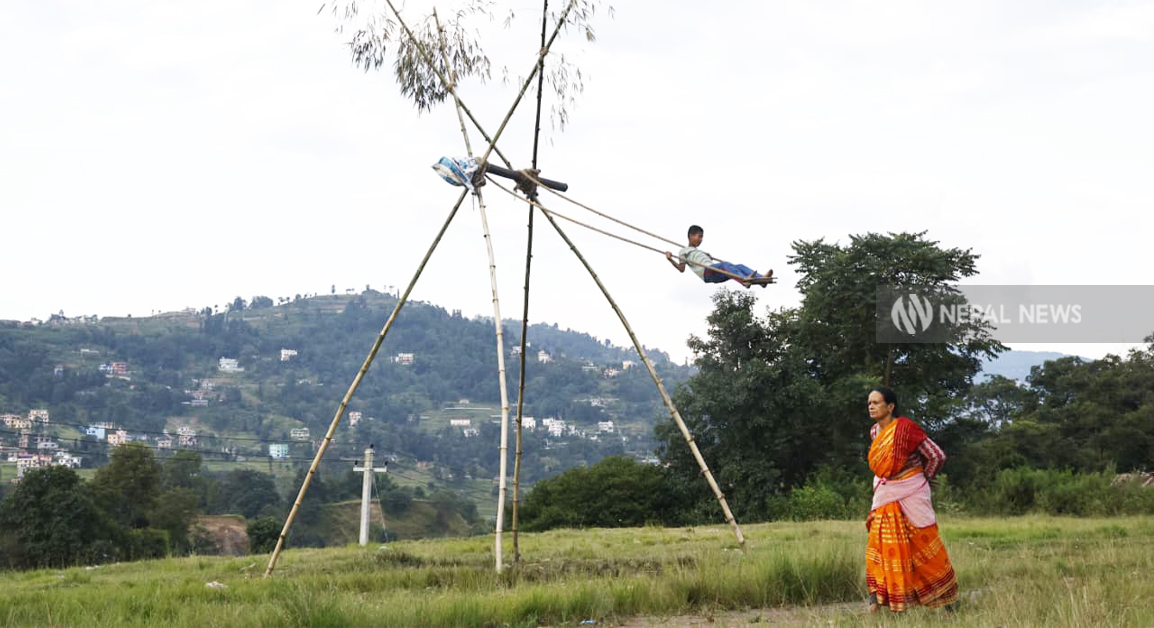

Dashain is a festival deeply rooted in the hearts of Nepalis. It is not just a celebration but also a harmonious bond of family, community, and culture.
Waiting for Dashain, preparing for it, and celebrating with joy has always been an integral part of my life.The Dashain moments of childhood now feel like folklore when recalled, but the memories still bring excitement.
With the passage of time, modernity has changed the face of Dashain. Facilities have made life easier, but the intimacy and sweetness of the past have been somewhat overshadowed. There is a vast difference between the Dashain of my childhood and the Dashain I now experience in middle age.
Excitement of new clothes
In my childhood, wearing new clothes during Dashain was not just tradition but a celebration. Ready-made clothes were rare; tailored outfits stitched by local tailors were the norm. I still remember my father traveling with bundles of cloth from remote Sindhuli’s Bitijor to Janakpur.
At that time, new clothes in Dashain were not mere coverings but “dreams.” We counted days on our fingers, waiting for the chance to wear them. The village tailor carried the responsibility of stitching our dreams. Watching the tailor cut fabric, thread the machine, and stitch was thrilling.
Sometimes the tailor would say, “Not finished today,” and we returned disappointed. One year, the tailor could not complete our clothes, and I had to receive tika from my grandparents in torn clothes. That pain is still fresh.
Dashain was also about showing off new clothes and shoes among friends. There was playful competition over whose clothes looked better. Walking around the village in new shoes made me feel like I owned the world.
Taste of beaten rice, banana, and meat
The kitchen in Dashain was incomplete without chiura (beaten rice), bananas, and meat.
My mother soaked paddy, roasted it in clay pots, and pounded it into chiura in the dhiki or okhal (traditional manual wooden thresher). Those without a dhiki queued at neighbors’ houses. The taste of freshly pounded chiura still lingers on my tongue.
Banana harvests were preserved, cooked in earthen pots or pits. Goat meat dishes like pakku, bhutuwa, blood sausages, sekuwa, and curry filled the feast.
Every household had plenty of meat, and neighbors invited each other to share, exchanging the warmth of the festival.
Cleaning and decorating homes was also part of Dashain’s charm. Red, yellow, and white clay was used to paint houses. Roads and paths were repaired collectively. Everyone joined to fill potholes, clear weeds, and make the village neat. Such collective efforts bound villagers in unity.
On Phulpati day, rituals were performed. Villages set up bamboo swings (linga ping, rote ping). Collecting ropes, weaving them, and raising bamboo poles for the swing was a community event.
The sound of Malshree dhun (tune) marked the arrival of Dashain. Children checked daily if the jamara had sprouted. Decorating courtyards brought special joy. Kite flying competitions filled the skies, with playful rivalry over whose kite stayed longest.
The collective fairs during Navaratri were another highlight. We played langurburja (dice game) in the village grounds, proudly showing off winnings.
On Tika day, receiving blessings from grandparents with red tika and yellow jamara gave unique energy. Visits to maternal homes for tika and dakshina brought extra happiness, which we flaunted among friends.
Adults played cards while children watched eagerly. Visiting temples for Navadurga worship made the moments unforgettable.
Dashain overlaid by modernity
Now, preparations have become easier, but the excitement has faded. Ready-made and cheap Chinese clothes are available everywhere; there is no need to wait for Dashain. From goats to clothes, everything can be ordered online. The thrill of going far to buy things has been replaced by scrolling through screens.
Social media floods with Dashain greetings. Video calls replace sitting in grandparents’ laps for tika. Competitions over branded clothes have shifted to urban centers.
Traditional meat dishes still remain the soul of Dashain meals, but most people no longer slaughter goats at home; they buy meat from the market or dine in restaurants. Yet the taste of my mother’s cucumber pickle still reminds me of the old Dashain.
The jamara tradition continues, but many now buy ready-made jamara from markets. In cities, houses are painted with modern paints instead of clay. Machines repair roads instead of villagers.
Swings are replaced by amusement parks and malls. Malshree dhun is streamed on YouTube and Spotify rather than played in villages.
The value of tika and blessings remains, but physical distance and busyness reduce family gatherings. Temple visits continue but not as frequently as before.
Modern facilities and the economy
Online shopping has simplified Dashain preparations. E-commerce delivers goats, clothes, and food to the doorstep. Remittances from abroad fund household Dashain expenses, fueling market activity. Workers receive festival allowances, boosting the economy.
Yet, this economic bustle cannot fill the emptiness of the heart. I too now order online, but the excitement of shopping in crowded markets is gone.
The soul of Dashain still survives, but its color has changed. In the past, effort and love filled the festival—pounding chiura, cooking meat, painting houses, swinging on bamboo swings. Cooperation, music, and warmth made Dashain intimate.
Today, though online shopping, ready-made goods, and paints save time, the sweetness is lost.
Still, the essence of Dashain—family, love, and unity—remains alive. When we narrate old stories to the younger generation, their eyes shine.
Though modernity has cloaked its outer face, deep inside, the sweetness of those times still lives on.
(—Ghimire is a lawyer )